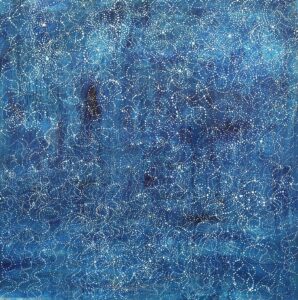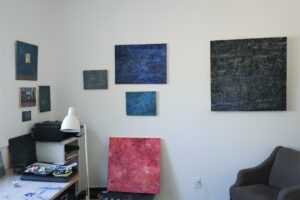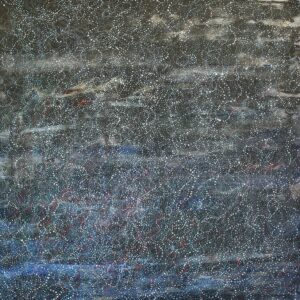A group of ex-voto paintings line the wall of a hallway leading into Donna Flax’s studio at her home in Wellfleet. She collected the paintings in Mexico, which she began visiting in the 1990s when her partner, Catherine Russo, lived there. “I was deeply affected by the artwork in Mexico,” says Flax.

Ex-voto or votive paintings are devotional works usually detailing a miracle received by a petitioner. In one of the images on Flax’s wall, a woman is depicted lying down with a distressed look on her face. Another woman in a black robe kneels, holding a candle and looking upward at two crucifixes. In the traditional format of ex-voto paintings, a short text at the bottom of the image clarifies the narrative. This painting, made in 1963, tells the story of someone who was sick with rheumatism and experienced relief through prayer.
Ex-voto paintings always have a mixture of suffering and salvation. This juxtaposition is also at the heart of Flax’s own work. “My paintings have always been some combination of the horrors and suffering of the world and some hope, salvation, or spiritual understanding of all that,” she says.
Flax is currently making abstract paintings composed of dots, but earlier works are more clearly connected to the ex-voto tradition. She still occasionally dips into that territory. On her desk is one such piece. As she painted it, she says, she thought it was too dreary.
“Where is the salvation?” she began asking herself. “Where is the hope?” Her colors started to brighten, and she incorporated religious symbols. There’s a strip of rusty brown at the bottom of the composition. It’s blank, but Flax says there’s going to be a story on it. A trail of marigolds, associated with Mexico’s Day of the Dead, snakes through the composition and leads up to images in the sky of a Buddhist lotus and the Virgin of Guadalupe.

Flax, who was raised Jewish, draws from a range of religious and mystical traditions. “I’m attracted to all forms of spiritual and mystical understanding of what the heck we’re doing here or what we should be doing here,” she says. After Sept. 11, 2001, she made a painting incorporating images of the destroyed twin towers and words from a Jewish mystical text. After a trip to Thailand in 2007, she began incorporating text from Buddhist thinkers and writers into her art. Alongside this interest in mysticism, Flax’s vision reflects the suffering of the times she has lived through, including “the dark years of torture and cruelty when George W. Bush was in office,” the ongoing conflicts between Israelis and Palestinians, and the years “when we were deep in the first Trump administration and everything was awful,” she says. Although an overt interest in spirituality came to Flax’s work later in life, politics were there from her earliest years as an artist.
Flax grew up in Walden, N.Y. and attended Cornell University before dropping out and moving to Boston in 1974 “to join the revolution.” She worked in a cookie factory, lived in a commune, and became part of the Boston Women’s Graphics Collective, making political posters that the group wheat-pasted around the city. Art, politics, and feminism became more compelling than formal education, but eventually Flax returned to school and earned a degree in human services and psychology from UMass Boston.

Flax moved to Provincetown in 1982. “I came for the summer and never left,” she says. In 1992, she had her first show at Albert Merola Gallery and continued exhibiting there regularly until it closed in 2023. She also started D. Flax, a graphics and silk-screening business. While running her business, she went to Lesley University to get a master’s degree in counseling and became a licensed therapist. “I was painting the whole time,” says Flax. Three years ago, she and Russo moved to Wellfleet.
Without a gallery or an exhibition to work toward, Flax feels that she’s painting for herself these days. “It’s liberating,” she says. A collection of recent paintings hangs on the walls of her studio. They all begin with an underpainting of color laid onto clay-surface panels with sponges and scrapers. The uneven dark and light areas flicker like obscured light. On one wall, she has three square paintings, each with a different blue ground. The paintings are covered with mazes of dots.
“I’m a dotter, not a splatterer,” she says. Although the mostly white dots look like splatters of paint, they are painstakingly painted one by one. The multitude of dots, layered and often forming a swirling pattern, seem to reference both the cosmos and the surface of water.
Flax’s dot paintings are informed by her readings of texts about astronomy and brain synapses, and there’s also a mystical undercurrent to this work. She mentions Carl Sagan and his arguments about our smallness — and seeming insignificance — in the universe juxtaposed with the greatness inherent in being connected to something so vast and grand. “In the times we’re living in, it’s helpful to have some kind of open-minded, open-hearted connection to the sky or the infinite or something beyond our particular moment of challenge,” says Flax.

But even looking to the sky, Flax continues to have her feet grounded in the present. In a black painting she started in 2023 and finished last fall, her mind was on the war in Gaza.
“How can you make a dot painting about Gaza and bombs and death?” she remembers thinking. “But I did.” In the painting, strings of white dots look like they could be trails of smoke in a night sky; the red dots look like splashes of blood. “There’s not a lot of hope in this painting,” she says, yet she draws attention to the upper portion, left relatively open and airy as opposed to the dense lower half of the painting.
“Something else is possible,” she says. “If the whole thing was dense, it would be a different painting.”

Like her ideas, Flax’s process is infused with a sense of the spiritual. Painting the dots is “a lot like meditation,” she says. “It doesn’t matter that your mind wanders. It matters that you notice it and bring it back. I use dots the way people use breath for meditation.
“There’s some effort and some thinking,” she says, “until I bring my brain, or just myself, back to another dot.”



